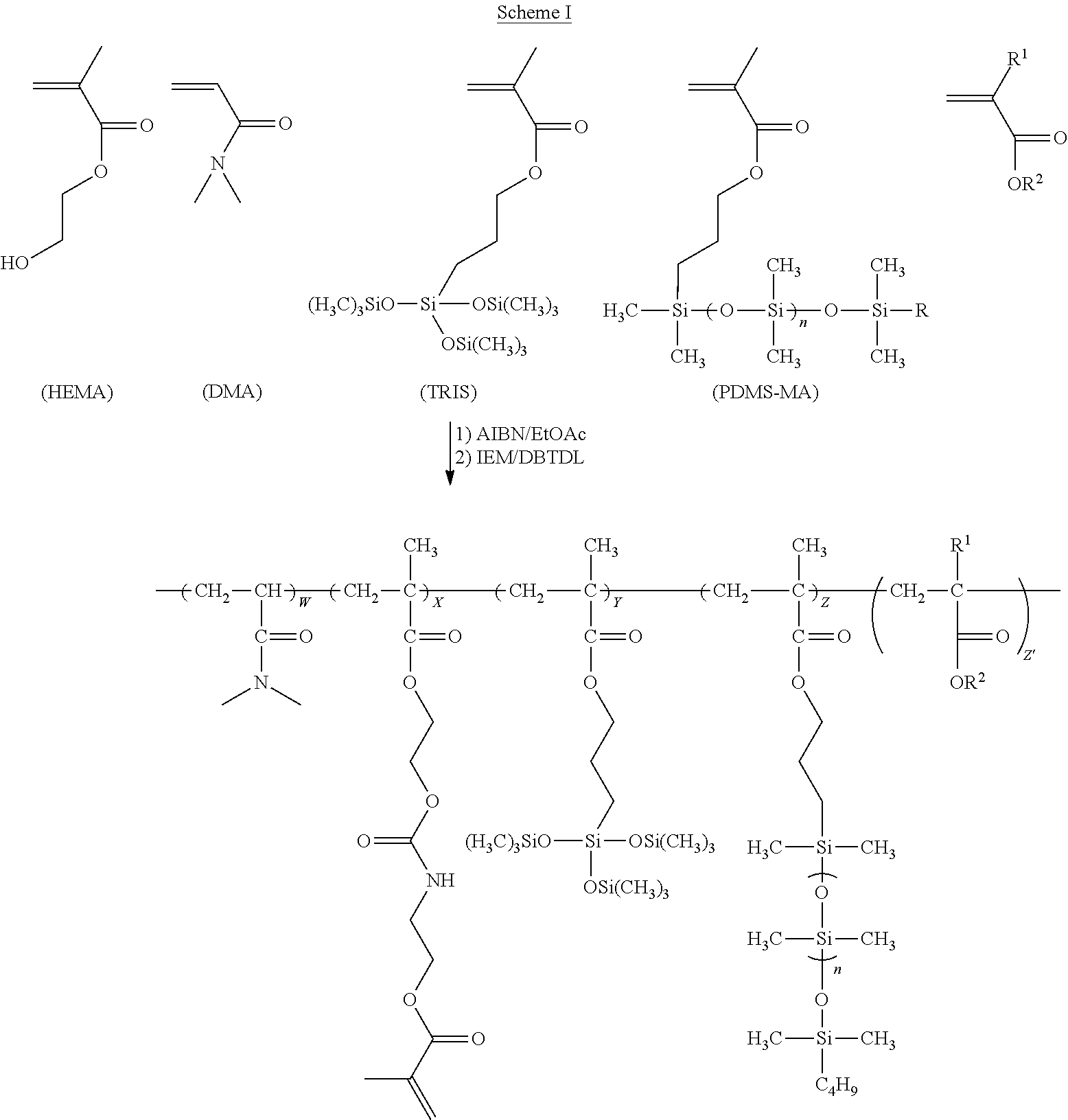Actinically curable silicone hydrogel copolymers and uses thereof
a silicone hydrogel and copolymer technology, applied in the field of can solve the problems of inks that are not well suited to make inability to cure inks, and inability to meet the needs of colored silicone hydrogel contact lenses
- Summary
- Abstract
- Description
- Claims
- Application Information
AI Technical Summary
Benefits of technology
Problems solved by technology
Method used
Image
Examples
example 1
[0130]This example describes synthesis of a precursor to a photo-curable binder polymer and synthesis of a photo-curable binder polymer.
Preparation of a Fluorine-Containing Copolymer (1600-53-1)
[0131]AIBN (0.8178 grams) is dissolved in DMA (158.54 grams), and then charged into a 1-liter glass-jacketed reaction kettle. The kettle is then charged with TRIS (100.81 grams), monomethacryloxypropyl terminated polydimethylsiloxane (60.21 grams) (Gelest brand, MCR-M17, MW˜5000), HEMA (40.20 grams), MMA (18.25 grams), 2-mercaptoethanol (1.0201 grams), 1,1-dihydroperfluoroethylacrylate (21.80 grams), and ethyl acetate (600 mL). The reaction kettle is equipped with a condenser, nitrogen inlet / outlet, and a stirring shaft / propeller system connected to an overhead stirring motor. Nitrogen is bubbled through the mixture for about 30 minutes at room temperature and then the mixture is heated to about 40° C. and stirred under nitrogen at about 300 RPM. The polymerization mixture is inhibited with 3...
example 2
Preparation of a Fluorine-Containing Copolymer (1600-52-1)
[0135]AIBN (0.8072 grams) is dissolved in DMA (152152.21 grams), and then charged into a 1-liter glass-jacketed reaction kettle. The kettle is then charged with TRIS (100.21 grams), monomethacryloxypropyl terminated polydimethylsiloxane (60.06 grams) (Gelest brand, MCR-M17, MW˜5000), HEMA (40.09 grams), MMA (12.21 grams), 2-mercaptoethanol (1.0331 grams), 1H, 1H, 7H-dodecafluoroheptyl acrylate (6.96 grams), and ethyl acetate (600 mL). The reaction kettle is equipped with a condenser, nitrogen inlet / outlet, and a stirring shaft / propeller system connected to an overhead stirring motor. Nitrogen is bubbled through the mixture for about 30 minutes at room temperature and then the mixture is heated to about 40° C. and stirred under nitrogen at about 300 RPM. The polymerization mixture is inhibited with 38.9 mg of 4-hydroxyTEMPO (dissolved in ˜10 mL of ethyl acetate) after about 48 hours of reaction at 40° C.
Preparation of Actinica...
example 3
Preparation of a Fluorine-Containing Copolymer (1600-80-1)
[0138]AIBN (0.8691 grams) is dissolved in DMA (158.54 grams), and then charged into a 1-liter glass-jacketed reaction kettle. The kettle is then charged with TRIS (96.82 grams), monomethacryloxypropyl terminated polydimethylsiloxane (57.20 grams) (Gelest brand, MCR-M17, MW˜5000), HEMA (38.45 grams), MMA (17.60 grams), 2-mercaptoethanol (1.0617 grams), 1H,1H-octafluoropentyl methacrylate (22.01 grams), and ethyl acetate (600 mL). The reaction kettle is equipped with a condenser, nitrogen inlet / outlet, and a stirring shaft / propeller system connected to an overhead stirring motor. Nitrogen is bubbled through the mixture for about 30 minutes at room temperature and then the mixture is heated to about 40° C. and stirred under nitrogen at about 300 RPM. The polymerization mixture is inhibited with 41 mg of 4-hydroxy-TEMPO after about 48 hours of reaction at 40° C.
Preparation of Actinically-Curable Fluorine-Containing Copolymer (160...
PUM
| Property | Measurement | Unit |
|---|---|---|
| molecular weights | aaaaa | aaaaa |
| surface tension | aaaaa | aaaaa |
| particle size | aaaaa | aaaaa |
Abstract
Description
Claims
Application Information
 Login to View More
Login to View More - R&D
- Intellectual Property
- Life Sciences
- Materials
- Tech Scout
- Unparalleled Data Quality
- Higher Quality Content
- 60% Fewer Hallucinations
Browse by: Latest US Patents, China's latest patents, Technical Efficacy Thesaurus, Application Domain, Technology Topic, Popular Technical Reports.
© 2025 PatSnap. All rights reserved.Legal|Privacy policy|Modern Slavery Act Transparency Statement|Sitemap|About US| Contact US: help@patsnap.com



